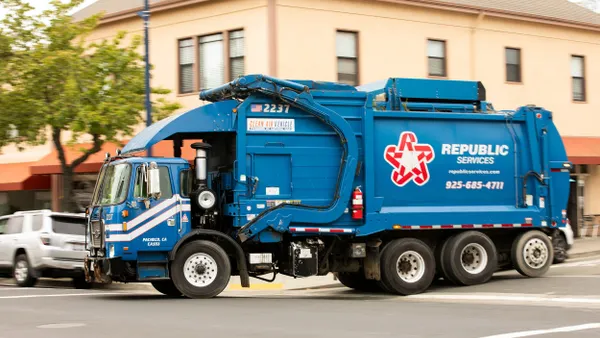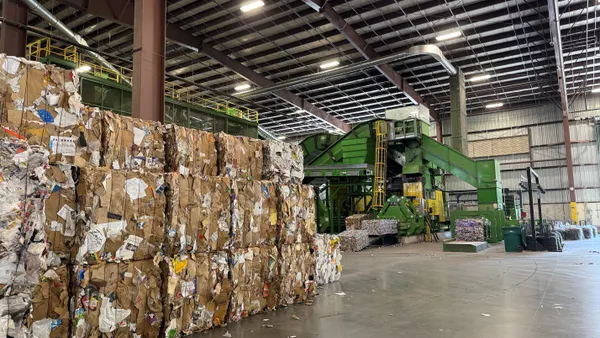Dive Brief:
- The End of Waste Foundation (EOW), a California-based group seeking to expand glass recycling with a unique blockchain concept that connects all elements of the supply chain, recently reported it has recovered 2,625 tons of glass since launching in June 2019. The startup hopes to scale up to 15,000 tons for 2020.
- Current partners include Momentum Recycling in Colorado, Ripple Glass in Missouri and Truett Hurst Winery in California. EOW is also focusing more on areas where glass collection has been suspended and collection radiuses could be expanded, because one of the main issues for glass recycling profitability is hauling, according to public relations manager Nikolas Zelinski.
- Another focus is getting more funding from investors, manufacturers and residents interested in participating. Founder Ionut Georgescu told Waste Dive his goal is to reach $1 million in revenue this year, with the hope of scaling to a level that could attract venture capital funding of around $10 million. With that in hand, EOW anticipates it could handle 500,000 tons in 2021 and possibly 1 million tons in 2022.
Dive Insight:
EOW launched last year with notable appearances at industry events and a unique "distributed shared responsibility" concept. The startup's software platform uses blockchain technology to track material from haulers to MRFs to processors to manufacturers. This creates a certificate verifying tonnage, path to recycling and greenhouse gas emissions offset once the loop is complete.
Certificates are valued at $70 per ton, with the idea being that stakeholders interested in verifying the material gets recycled will pay into the system, and that those involved in the operations will share in the revenue. EOW currently takes 35% of those funds for management costs, but could reduce that to 15% when it surpasses 1 million tons per year.
EOW has seen initial results, but Georgescu said the startup has been reworking its approach to enroll more companies and conversations are underway with other wineries to purchase the material. EOW has also launched a social media campaign called "Save the Glass" to enlist citizens and allow for them to make monthly contributions.
Working through these logistics, and testing out the overall concept, has also led EOW to update its vision on how this system works. "What we discovered is that in reality we are building a transactional platform and we are building a digital circular economy through our system," said Georgescu.
Part of this evolving strategy includes increased emphasis on municipal partnerships, including the potential for EOW to pay local governments directly. This comes as a growing number of municipalities cut glass from their curbside recycling programs, often at the request of haulers, due to regional market issues. Yet glass recycling proponents believe this is a solvable issue with new investment in collection methods and possibly regional processing infrastructure where needed.
“If we really want to make a big dent or a big increase in the amount of recycled glass that’s used to make new containers, we’ve got to go where the glass is and where the plants are," Scott DeFife, new president of the Glass Packaging Institute (GPI), told Waste Dive. "We’re modeling several different programs to see if we can roll one or more out as pilots in different regions."
Both GPI and EOW confirmed discussions are currently focused around areas such as Denver, Phoenix and the Washington, D.C. metro area. Recent media realizations that glass from Baltimore has been used as landfill cover for years are among the reasons more transparency could be valuable.
Georgescu also said it is critical consumer packaged goods companies with sustainability targets step up to purchase more recycled cullet, mirroring a broader push for manufacturers to use more recycled content. He also called on service providers to consider the long-term implications of dropping glass entirely, as residents may still try to recycle it and some MRFs have already invested in technology to separate it.
“They made the first financial assumption that glass is something that is not good for them to deal with, but if they already have the technology to separate glass in a MRF, don’t stop it," he said. "Because they will lose more money.”
While glass collection is still a common service in many curbside programs – especially when markets are close enough to justify transportation costs – much of it is still not being recycled. The U.S. EPA’s latest statistics estimate more than 73% of glass generated in 2017 went to landfills or incinerators. EOW’s goal is to help verify the path of the nearly 27% being recycled and also start shifting that ratio.
Various unknowns remain, however, as the glass recycling sector eyes fallout from extended producer responsibility proposals and other trends, including rising interest given anti-plastics sentiments. And while EOW is also exploring the potential to expand into materials such as aluminum, its success may hinge in part on whether large-scale logistical and funding solutions can be found for glass.












